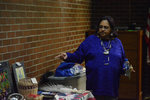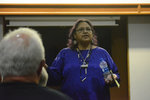

When LaVerne Kearns was a child, her father wouldn’t teach her any of the tribal traditions he had grown up with.
“When I asked my father about some of the Muscogee traditions, he said, ‘You don’t need to know that. That will just get you in trouble. Just leave it alone,’” she said. “When I asked my mother, she finally relented and taught me how to do a round dance. But it was secret, no one was there, and she put on a tape she had bought. She taught me how to round dance and she said, ‘Don’t tell dad.’”
Kearns is a descendant of the Kansas Kickapoo and Muscogee tribes, but she grew up unable to fully claim her heritage. Her parents had been sent to an Indian boarding school — where they met — which was designed by the government to strip away their language and culture.
“Boarding schools were put in place by the government to kill the Indian inside the person,” Kearns said.
Arriving at such schools, Native children often had their hair cut and placed in a bonfire along with their possessions. Many, like Kearns’ grandmother, were beaten for speaking their Native language. The legacy of those schools — and many other attempts to stamp out indigenous culture — is still felt today, including in Washington.
“I wasn’t allowed to be Indian,” Kearns said of her childhood.
Over the years, Kearns has learned to reclaim many traditions and teachings, and she shared that knowledge Saturday at the Centralia Timberland Library — while addressing myths and misconceptions about First Nations.
“I would not have been able to do this 20 years ago,” Kearns said of the event, noting that despite that progress, there’s still much learning that needs to be done.
Kearns recalled as a child being thrown out a store in Klamath Falls, Oregon, along with her grandmother, just for being Indian. A counselor in college used her race as a reason to dissuade her from pursuing pre-medical studies.
One of the myths she touched on, that Indians are stupid, has been disproven in her own family, she said, as all of her children have college degrees.
She also addressed the war paint and clothing worn in Hollywood movies, Halloween costumes and other popular culture. Most of it is wildly inaccurate, she said, and often represents cultural insensitivity or outright appropriation. Kearns noted the origin of the actor Johnny Depp’s face paint look in the film “The Lone Ranger.”
“This is from a painting from a white artist who made this up,” she said. “Why Johnny Depp decided he was the example is beyond me.”
The mascots and logos of many sports teams, Kearns noted, are also inappropriate. The term “redskin” refers back to a time when the government placed a bounty on the scalps of Indians. The fact that tribal images, words and art have become so widespread in non-Native culture means many non-tribal members often don’t give much thought to what they represent.
“It’s so ingrained now,” she said. “Like dreamcatchers — now they’re made in China.”
Kearns said her own journey of reconnecting with her heritage involved learning about the Muscogee Tribe’s history near Savannah, Georgia. She learned dances and began attending powwows. She painted a tipi for her thesis at the Pacific Northwest College of Art. She learned how to make baskets.
“I’m still learning,” she said.
Of course, she’s teaching as well, and the audience Saturday was eager to hear her story of claiming her identity. She described why Degree of Indian Blood cards are important, why treaties still matter and noted many Indians who have made remarkable contributions to American society.
Beyond art and history, Kearns talked about the importance of the Native way of life that settlers could not understand. Her grandmother, she said, told her of the time when buffalo roamed free on the plains, before they were systematically slaughtered by whites.
“There wasn’t any want at that time,” she said. “No one went without and it was all shared. What more could you ask for?”
That approach, viewing the land as a shared resource, is one that has relevance today, she said.
“The problem we had from Day 1 is that tribes did not think of land as ownership. It was for everyone,” she said. “We are keepers of the earth, and we’re trying to keep the water clean, the air clean, and everything else clean, not just for the tribes but for everybody. … That’s what the tribes are. For some reason that seems to have passed by the wayside.”